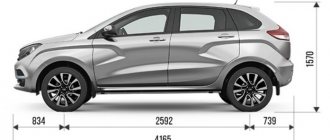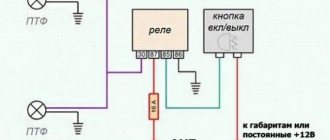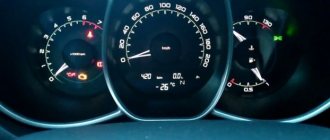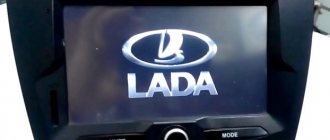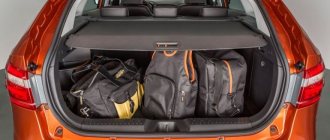After purchase, any new car should be used carefully, as parts are worn in. The duration of this period and precautions depend on the manufacturer and the specific model. The new car from AvtoVAZ, Lada Vesta, is equipped with both engines that have been in production for a long time (the running-in process of which has already been worked out), and a new product developed specifically for it. Therefore, the recommendations for operating the car during the first thousand kilometers contain features that its owners should take into account.
Running in Lada Vesta - recommendations and requirements
Buying a new car is always a joyful event. But it is always associated with a number of difficulties - choosing a model, paperwork, constant technical control, and official service. But the most important thing in this is the running-in. Without this, it is impossible to properly operate any new car that was just purchased at the dealership. Running in a new Lada Vesta car must be carried out in accordance with the manufacturer's requirements.
Features of running-in mechanics
The instructions for running in the Lada Vesta include the following points:
- the difference in braking forces should not be allowed to significantly exceed (no more than 35 percent);
- It is recommended to change gears smoothly so as not to overload the engine (but, of course, you also need to take into account the road situation).
The gears in the box must be ground in - this is important for the “mechanics” to ensure further satisfactory operation.
Although many car enthusiasts are sure that running in the mechanics is not really necessary, the manufacturer’s recommendations say otherwise. After a couple of thousand kilometers of grinding in, the power part of the car will work better.
After purchasing a new car, owners try to use the car carefully for the first time, because... During this period, grinding in of parts occurs. How many kilometers to hold back the full capabilities depends on the manufacturer, but most often this is the first thousand kilometers. Do you know what a proper car break-in should be?
The operating manual for Lada cars (XRAY, Granta, Priora, Vesta, Kalina, Largus, etc.) contains the following recommendations for the first 2000 kilometers:
- do not tow a trailer or another vehicle;
- after driving the first thousand kilometers, check the tightness of the wheel bolts and, if necessary, tighten them;
Breaking in the engine of a new car is as follows:
- In a timely manner, in accordance with road conditions, engage higher gears in the gearbox, avoiding
- engine overload (for manual transmission);
- Do not start abruptly, including with the handbrake on, or make a U-turn with the front wheels slipping at maximum engine speed, as this will damage the differential.
- do not exceed the speeds indicated in the table.
| Mileage, km | Transmission in gearbox | ||||
| first | second | third | fourth | fifth | |
| 0 – 500 | 20 km/h | 40 km/h | 60 km/h | 80 km/h | 90 km/h |
| 500 – 3000 | 30 km/h | 50 km/h | 70 km/h | 90 km/h | 110 km/h |
Features of the Lada Vesta run-in:
- You should adhere to the rules only for the first 2000 km.
- when driving the car, do not exceed a speed of 110 km/h and an engine speed of 3500 min-1;
- Until the end of the run-in, the relative difference in the braking forces of the wheels of the rear axle is allowed to be no more than 35%.
After the run-in period, you can gradually increase the engine speed and vehicle speed. Running in a new car with an automatic transmission or AMT (robot) is no different from the usual mechanics.
Warning! The performance of new tires, brake pads and discs, and clutch is optimized only after they have been run in (grinding in). Therefore, for the first 500 km, use a restrained driving style with moderate acceleration. If during further operation the specified components are replaced, then follow the break-in instructions again.
Leave your recommendations on how to properly break in a new car. Other tips for using Lada can be found in this category.
Key words: universal article
General requirements for operating new Lada cars
According to the rules, running-in should be carried out over several thousand kilometers with a maximum speed level of no more than 3 thousand. This is very important for a new engine.
Under these conditions, this procedure allows:
- promptly identify deficiencies or defects in components and motors;
- grinding of parts occurs;
- carry out adaptation of the brake system, suspension, chassis, transmission.
Proper running-in has several strict prohibitions:
- turn sharply and brake;
- revolutions - no higher than 3.5 thousand (the maximum frequency allowed by the manufacturer);
- Towing trailers and other vehicles is prohibited.
After the car passes the first thousand, it is necessary to check the wheel fastenings. It is prohibited to increase the speed indicated in the car diagram. After the break-in is completed, the speed can be increased gradually.
Related link:
Heated windshield on Lada Vesta.
Fans disagree about running in Lada Vesta
Driving the Lada Vesta There are opinions among the owners of the domestic new car, some of whom are in favor of the fact that it is necessary to run the new engine for 2,000 km in a quiet mode, others deny this method. Still, the first statement has more supporters, and besides, the designers themselves strongly recommend carrying out a full grinding in of the parts of the new car (engine, transmission, brake system).
On a note!
If you bought a Lada Vesta in winter, do not hesitate to warm up the engine longer and start driving without jerking. This will ensure the safety of components and eliminate the need to visit repair centers, which takes away the time of a busy person.
- Car owners with extensive experience in car operation advise: in order to run-in the Lada Vesta engine safely and rationally, you should avoid crowded city roads with permanent traffic jams. The systematic process of grinding in automotive parts requires smooth running of the internal combustion engine, and large streets are characterized by constant stops.
- An important element of the entire break-in process will be an oil change after two thousand miles. During active grinding of components, metal shavings get there, which naturally spoils the brake fluid.
- Any new car may have specific problems. At first, the Lada Vesta transmission is characterized by slight jerks. The developers reassure buyers that after a thousand kilometers, this problem will go away on its own, and one can observe calmness and elasticity in work.
- If you fill the gas tank with fuel of the wrong quality, an unpleasant clicking sound may occur. You should not save on fuel if the owner values vehicles on wheels.
The number of kilometers the run-in lasts will determine how long the car will serve you. It can be compared to warming up a runner's body before a marathon, where every cell of the body becomes ready for heavy loads. A car part, gradually developed, carries greater potential and is able to remain at its peak efficiency longer. Running a Lada Vesta for two thousand kilometers is not so long that you don’t want to do it for the sake of long-term and rational operation in the future.
Alarm Lada Vesta
Lada Vesta with mileage 50,000 and 100,000
Special requirements and recommendations for running Vesta
Whether the new Vesta needs a break-in, the manufacturer answers unequivocally - definitely. Before running the car, you should fulfill several important requirements:
- check tire pressure;
- check the engine for possible engine oil leaks;
- The car must be fueled only with high-quality fuel.
During the first thousand, the main grinding in of all parts takes place. During this time, it is prohibited to travel at speeds exceeding 90 km/h. Do not allow the engine to idle for a long time - in this mode the engine experiences heavy loads. At first, if possible, move not on streets congested with cars, but on free highways. Try to choose roads that have good surface. Extreme movement is strictly prohibited. The first fifteen hundred kilometers are very important. Experts recommend adhering to a gentle regime for the first 2-5 thousand kilometers, after which you can proceed to normal operating mode.
Primary requirements
Taking into account the manufacturer's recommendations, adhere to the speed limit.
| Mileage km | Recommended gear in the box at the speed of the Lada Vesta | ||||
| First | Second | Third | Fourth | Fifth | |
| 0-500 | 20 | 40 | 60 | 80 | 90 |
| 500-3000 | 30 | 50 | 70 | 90 | 110 |
Important!
All elements of the brake mechanism, as well as clutches and new tires, return to operating mode after running-in. The same is true when replacing the above parts during repair or replacement.
Preparing for use of the gearbox
The run-in of a Vesta with a robotic gearbox is identical to that of a model with a manual transmission. However, in this case there are additional requirements.
Before you start driving, you need to warm up the car a little and only then drive. This is necessary so that the filled lubricant enters the transmission elements. This way, thickened oil will not accumulate in the box.
When working with mechanics, it is forbidden to allow a large excess of the difference in braking forces. You need to change gears smoothly, do not overload the engine, but always focus on the situation on the road. It is very important for mechanics that the gears get used to it.
Correct running-in
The instruction manual for my Granta gives the following figures:
- When driving 0-500 km, the maximum speed in 5th gear is 90 km/h
- With a mileage of 500-3000 km, the maximum speed in 5th gear is 110 km/h
Run-in lasts up to a mileage of 3000 km. This is followed by zero maintenance. Next - complete freedom of action
In addition to maximum speed, there are other recommendations for proper break-in:
- Do not rev the engine above 3500 rpm
- Do not overload the engine in low gears, switch to higher gears in time (every 20 km/h)
- Do not tow trailers or other vehicles during break-in.
After driving the first thousand, it is recommended to check the tightness of the wheel bolts, if necessary, tighten them ( Lada Granta. Operating manual for the car and its modifications
).
Reviews
| Positive | Negative |
| I read a lot of negative reviews, and my husband and I spent a long time deciding whether to use our Vesta or a better-equipped Chinese one. We stopped at Vesta. The set of functions is enough for us. We are pensioners and music, a camera and other useful functions are enough for us. During the running-in period, nothing broke and no noise appeared. Fuel consumption has not changed. | I bought Vesta 2022. The service center said that the model is new, the car is modern and does not need to be broken in. There is a lot of controversy about this on the Internet; specialists at service stations and services claim that this is necessary. Otherwise, serious problems may arise. The car is not bad, but I am dissatisfied with the official service. |
| This is my first car and I really like it. I was afraid that the domestic car would upset me, so during the run-in I listened very carefully to any noise and followed the instructions. I travel a lot and have already covered almost 50 thousand kilometers in three years. There were no special problems, I constantly monitor the condition of the car and use only original spare parts and consumables. | The car is 2022, purchased in the middle of summer. Run-in in warm weather was normal, and in winter it was practically not used. As a result, in the spring, when everything dried out, the first problems began. After 5 thousand mileage, a sound appeared like a broken muffler. A superficial inspection of the car revealed no problems. There was no opportunity to take it in for service, so I decided to wait and practically didn’t drive Vesta. After 8 thousand mileage the sound disappeared on its own. The service later said that this is how it should be - resonance of the exhaust system. |
| The car completely pleases me with its equipment, quality and comfort. The run-in went well, there were no problems. In two years the car has already driven almost ten thousand and everything is fine. | At first everything was not bad. But literally immediately after two thousand mileage, an unpleasant sound appeared in the box, reminiscent of the “nine”. The service station did not reveal anything, so I decided not to resort to major repairs for now. |
| I was choosing between Duster and Vesta. I decided to save money and support the domestic manufacturer. I liked the set of functions and build quality. The cabin is quiet, the seats are comfortable, and the controls are comfortable. | The domestic auto industry, you can’t say anything. It seems like the car is new and everything is like the Europeans, but not everything. At first nothing, everything was fine, but after a month there was a tremor in the exterior mirrors. The dealer said this is normal. If it falls off, then come for a replacement. |
| There is no way to buy an expensive foreign car. I thought about buying a used one, but then, on a recommendation, I bought our Lada. The package includes cruise, heated seats, a rear view camera, a wide trunk, a lot of space in the back - I'm happy with everything and don't regret it one bit. | I regretted the money spent, I’m thinking of selling and it’s better to take the same Duster. Constantly in wet weather there is a terrible creaking of the stabilizer bushings. The officials said they could lubricate it, but only at my expense. Besides, this won't last long. I solved the problem myself using zinc chain lubricant, so far so good. |
Related link:
Roof rack sv cross price review
Vesta has become a symbol of the new era of AVTOVAZ. Modern technologies, original and recognizable design, high quality. However, the car has enough problems; it does not always please its owners. The manufacturer has room to grow and something to do. But drivers themselves must remember that any car requires appropriate care. And if you are purchasing a new car, be sure to run it in.
What is better to redo right away?
“First of all,” Evgeniy shares his experience, “you need to replace the engine cushions and nuts on the muffler corrugation. The corrugation will still burn out in a couple of months, but replacing it later will be very troublesome, because the nuts used are steel, not brass. They burn, and it is almost impossible to unscrew - the stud is 8, the nut is 10, and if you tear off the edge, then consider yourself an adventure. Therefore, we change the nuts to 13. By the way, the muffler itself looks quite rusty on everyone, but so far I have not heard of anyone having it burn through.
For inexpensive but useful modifications, I recommend purchasing an additional “stove” air intake mesh. There is none at the factory, and all the debris goes straight to the heater radiator - and this is fraught with the appearance of unpleasant odors in the cabin and strange noises when the fan grinds all the debris that gets inside.
Another recommendation is to reflash the coolant temperature sensor. Here it is stepped, works with a large delay, and it is quite possible to “boil.” Therefore, you need to reflash to linear.
Well, then - as desired. I slightly modified the intake system: now the air intake is not right next to the radiator, but a little higher. I also highly recommend replacing the firmware of the engine control unit. Just don’t skimp, don’t buy the cheapest ones - read the reviews on the forums, choose a decent one, because novice flashers can easily kill your engine.
What will it give? Improves the connection between the engine and the gas pedal. If now it can be seen that the pedal is electronic, then there is a complete illusion that there is a cable. After the firmware update, the engine itself feels more elastic, and the Vesta’s annoying feature of twitching when driving through yards when driving in second gear, at idle speed, has also disappeared. In addition, the firmware also makes it possible to select an economical driving mode - but we, as they say, did not agree on character. For the 1.8 engine, the firmware gives an even more pronounced effect, but there it is single-mode.”




